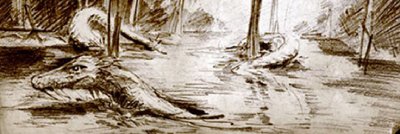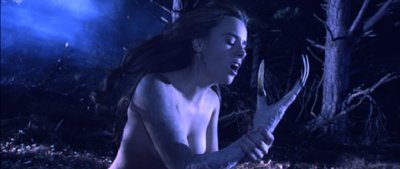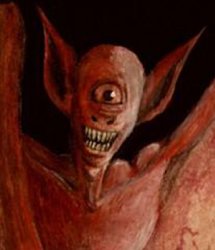Tim Cameron’s Seven Weird Mythical Creatures: Commentary
Posted by: Loren Coleman on May 6th, 2008

Comedian Tim Cameron at Cracked.com has set out to name the most outrageous “creatures,” which I guess we might assume could include a cryptid or two.
His new list is entitled the “Weirdest Mythical Creatures in the World,” and I thought I’d share the essence of his gathering. Despite the profanity-injected narrative, which I found sometimes not-too-funny and distracting, the compilation was worthy of a look, as Cameron pointed to some overlooked alleged beasts.
The creative list with a few of Cameron’s quoted but edited comments, without his “how to kill” them conclusions, is below. I truly did find the list interesting, although the juvenile pull to bathroom humor in the entire piece (see here) was not something I needed to re-publish wholly at Cryptomundo.
For me, the lesson learned in reading the underlying nonfiction part of Cameron’s list is that some tales of really weird beasts do tend to gross out other peoples’ cultures when taken out-of-context. Cameron’s use of the word “mythical” may be quite appropriate, except in the case of the Mongolian Death Worm, for most of this collection.
Tim Cameron’s Seven Weird Mythical Creatures
#1. Europe: Rat King

Some of what Cameron talks about are more Fortean wonder versus cryptozoology, including his first selection, the Rat King, which is a favorite of Fortean Times. The Rat King happens when “several rats become joined at the tail, combining to form one writhing mass of filth and squeaks that spins through town like a horrendous plague-tipped cartwheel. In Medieval times, seeing a rat king was taken as a bad omen, which was a bit of a no-brainer, really.”
As Cameron writes: “There are actual specimens of these in museums. The first recorded sighting of a rat king was in 1596.”

#2: Philippines: Tikbalang

“The Tikbalang is a tall, hairy humanoid with the head of a horse and legs so long that they stretch above its head when it sits down….it makes its home in the deep forests of the Philippines….”

#3. Laos: Phaya Naga

“On certain stretches of the Mekong River, an evening walker can behold a magical sight. At around 8 pm during the full moon of October, hundreds of egg-sized balls of red flame rise from the water like a myriad misdirected Hadoukens, floating up towards the stars, where they quietly disappear. Locals claim that these fireballs are caused by an eel called the Phaya Naga, specimens of which have allegedly been found.”

“In 2003, reporters from a Thai television station claimed that the fireballs were simply tracer bullets, fired as part of the Buddhist celebrations. The Laotian government responded by arresting the reporters.”
#4. Mongolia: The Death Worm

(This is a very familiar cryptid to cryptozoologists, and may be the one that is the most well-known on Cameron’s gathering.)
“The allghoi khorkhoi, or ‘blood-filled intestine worm,’ is a delightful little fellow approximately three feet in length that supposedly lives under the Gobi desert, slithering to the surface during the rainy season in order to prey upon camels and horses and generally be horrible. Its crimson body resembles a length of cow intestine. The Death Worm is capable of spitting deadly yellow venom at its victims, and also of firing ranged electric shocks strong enough to kill a man instantly, or power a modest refrigerator for up to three hours.”

(Even real cryptozoologists have searched for the Death Worm, as did the CFZ in 2005, and Adam Davies in 2008.)
“It was first brought to the West’s attention by Roy Chapman Andrews, the adventurer said to be the inspiration for Indiana Jones.”

(Of course, the field for the inspiration for Indiana Jones is getting rather crowded, as well as cryptozoologically-inspired too.)

#5. Germany: Wolpertinger

“The wolpertinger is a cute little bunny that sports antlers, wings and fangs. Its home is the Black Forest of Bavaria, where it probably spends most of its time being extremely confused. Wolpertinger have the horns of a roebuck, the wings of a jay and the feet of a duck, making them the only animals capable of both aquatic and mid-air rutting.”

“There is some evidence for creatures like the Wolpertinger, or at least there are actually antlered rabbits out there. The Shope Papilloma virus causes horny, cancerous growths to appear on a rabbit’s head and body, often giving it the appearance of having antlers. This doesn’t explain the wings, unless there’s also a kind of cancer that makes you fly.”

(Was the virus – see the effects above – the cause of the inspiration for the Wolpertinger and the Jackalope?)
(The Wolpertinger is sort of the Germanic version of the Jackalope, and seems to share the stage with the Jackalope – below – for being more of a taxidermy creation than a cryptid.)
#6. Philippines: Manananggal

“According to folklore in the Philippines, your standard manananggal has the body and face of a beautiful older woman, with a couple of minor differences, such as its leathery wings and its ability to detach its torso and fly away sans legs. Manananggals terrorize the Visayan islands, where people hang large amounts of garlic around their houses as a deterrent to the manananggal, which seems unnecessary since the legless things probably don’t have the ability to land.”
#7. Tanzania: Popobawa

“Legend says that the beast known as Popobawa has been menacing the Tanzanian island of Pemba in his own unique style ever since the ’70s. He can be identified by his smell (reputed to be quite pungent), and also by the fact that he is a one-eyed flying ogre…”
(Some of Cameron’s critter descriptions are not for young children, please be warned. Certainly, the entry on the Popobawa is one of those. In general, the list is entertaining, enlightening, and a head-scratcher, all at the same time.)
About Loren Coleman
Loren Coleman is one of the world’s leading cryptozoologists, some say “the” leading living cryptozoologist. Certainly, he is acknowledged as the current living American researcher and writer who has most popularized cryptozoology in the late 20th and early 21st centuries.
Starting his fieldwork and investigations in 1960, after traveling and trekking extensively in pursuit of cryptozoological mysteries, Coleman began writing to share his experiences in 1969. An honorary member of Ivan T. Sanderson’s Society for the Investigation of the Unexplained in the 1970s, Coleman has been bestowed with similar honorary memberships of the North Idaho College Cryptozoology Club in 1983, and in subsequent years, that of the British Columbia Scientific Cryptozoology Club, CryptoSafari International, and other international organizations. He was also a Life Member and Benefactor of the International Society of Cryptozoology (now-defunct).
Loren Coleman’s daily blog, as a member of the Cryptomundo Team, served as an ongoing avenue of communication for the ever-growing body of cryptozoo news from 2005 through 2013. He returned as an infrequent contributor beginning Halloween week of 2015.
Coleman is the founder in 2003, and current director of the International Cryptozoology Museum in Portland, Maine.










The first photo of the Wolpertinger comes from the Jagdmuseum (a museum about hunting) at Munich, I have this photos also as a postcard. Many years ago there was a big exhibition about the Wolpertingers, but there is now only a big showcase with about a dozen different ones. The Wolpertinger is actually not even always some kind of rabbit, there are a lot of completely different types, some of them even with duck-beaks. Some are made of rabbits, others have their general shape based of foxes or big rodents.
It is actually quite probable that the origin of the wolpertinger can be found in this papillom-virus caused disease. There are very old drawings of a “horned rabbit”, even in Gesner´s Historia animalium. Last year I read a very interesting book about hunting in the last centuries, and there was a whole and detailed chapter about the “horned rabbits”, including many old drawings and paintings of rabbits with strange little antler-like structures, and it seems that the origins of the kind of cryptid are already very old.
In Filipino comics, the Tikbalang gave the equally bizarre hero, Flash Bomba, his powers.
http://www.internationalhero.co.uk/f/flashbomba.htm
I kinda like the idea of going on a Mongolian deathworm hunt carrying a small refridgerator, so that when you catch one you can plug it in and toast your success with a cold beer.
o.0
You just boosted your site hits by a few thousand…the Wolpertinger was a pet given in World of Warcraft’s’ brewfest, and I think that anyone trying to find the pet and finding your site will have a good chance to be hooked.
I’m a bit disheartened that Ciguapa didn’t make that list…
Hmmm. not one of the best Cracked lists I admit. But I do occasionally enjoy their immature sense of humor
My favorite one is the Mongonlian Death Worm. Can electrocute you and spit acid at you.
“Destination Truth” did a show on it, of course. Hated the show. They did find some cool dinosaur bones, though.
I prefer the Jackalope to the Wolfpertinger.
Reminds me of Dave Coulier from “Full House” and his “America’s Funniest People” show back in the day. Had a recurring skit on the Jackalope.
“Fast as fast can be!!! You’ll never capture me!!!”
Funny stuff.
It’s nice to throw in
some humor once in awhile!
the manananggal reminds me of the borg queen from Star Trek First Contact, when she comes down from the top of engineering, above the warp core, and doesn’t have a body(or hair for that matter).
I saw a tikbalang several times. I am from the Philippines. The thing is I also see ghosts, fairies and many many other things. A tikbalang is a kind of spirit that lives on trees. Yes, tikbalangs do exist but not in the physical place like ours.
Hmm just wondering..does the Popobawa come in a purple, horned variety? If so it could be the origin of the famous “one-eyed, one-horned flying purple people eater”!